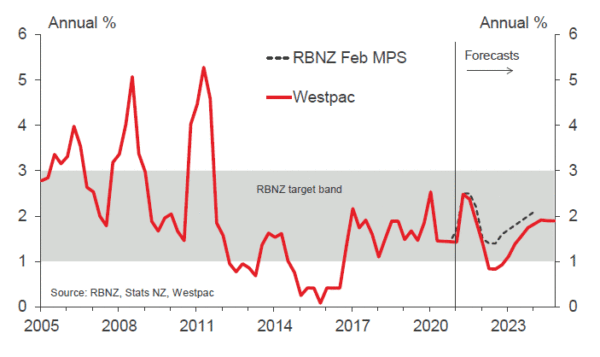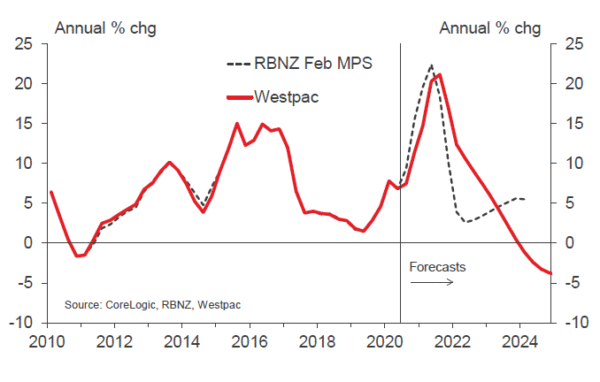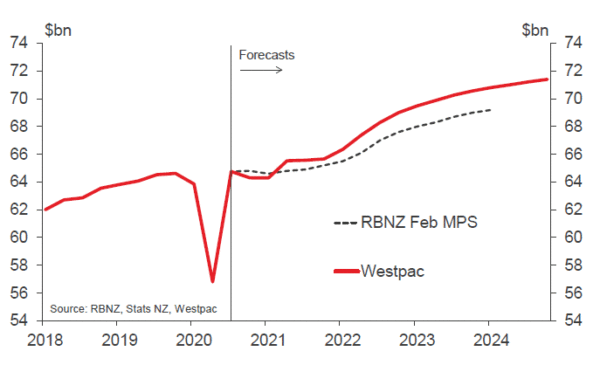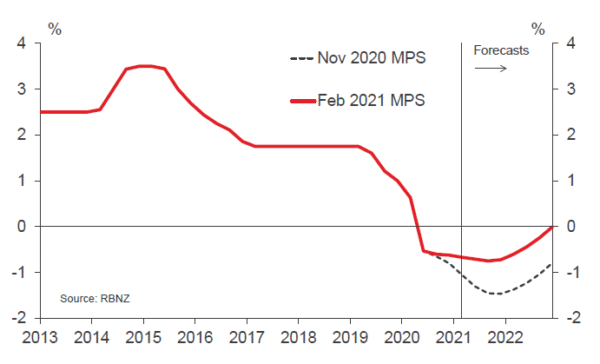- As expected, the RBNZ left all monetary policy settings unchanged today.
- The RBNZ resolutely expects to keep policy stimulatory for an extended period.
- Inflation is rising right now, but the RBNZ thinks this is temporary.
- The RBNZ wants to see the whites of the eyes of sustained inflation before it hikes.
- We remain comfortable forecasting no change in the OCR until 2024.
- The RBNZ is calibrating the pace of LSAP bond purchases according to the pace of government bond issuance
- That suggests it will stop well short of $100bn by June next year.
The Reserve Bank’s first Monetary Policy Statement of the year was firmly on-hold, with the OCR staying at 0.25%, the cap on the large-scale asset purchase (LSAP) programme remaining at $100bn, and no changes to the Funding for Lending Programme (FLP) for banks. The economic outlook is much more encouraging compared to their last update three months ago, and there’s no longer a strong case for additional monetary stimulus. But the measures that have already been put in place are likely to remain for a long time.
This was exactly what we were expecting from the RBNZ. Financial markets have been flirting with the idea that with further easing no longer on the table, the RBNZ could be tightening monetary policy next year. Today’s statement will go some way towards discouraging that view, although interest rates and the exchange rate haven’t moved much on the day.
The RBNZ is prepared to wait until it sees the whites of the eyes of sustained inflation before acting. That’s in keeping with the stance that many overseas central banks have adopted in recent months, though it’s a change from how central banks have traditionally behaved. Indeed, the record of the Monetary Policy Committee’s meeting noted that they “reflected on the international experience of central banks following the Global Financial Crisis” – a time when central banks tried to pre-empt a pickup in inflation pressures and ended up repeatedly undershooting their targets.
The RBNZ stated that it will “maintain its current monetary policy settings until it is confident that consumer price inflation will be sustained at the 2 percent per annum target midpoint.” The key word here is ‘sustained’, because inflation is in fact set to spike higher in the near term. Like us, the RBNZ expects annual inflation to have reached around 2.5% by the middle of this year, partly due to rising commodity prices and disruptions to global supply chains.
But these are temporary forces, and by mid-2022 the RBNZ expects inflation to have slowed to around 1.5%. Our forecast is even weaker than this, dropping to as low as 0.8% next year, partly because we see further upside to the New Zealand dollar exchange rate over the coming year.
Consumer price inflation forecasts
Looking beyond the near-term upside pressure on prices, the New Zealand economy is still running below potential, and employment is below its maximum sustainable level. Like us, the RBNZ expects that to remain the case this year, while the international border stays closed. Next year is expected to see a more substantial pickup in growth, as the global vaccine rollout allows a gradual resumption of international travel and tourism.
In the meantime, domestic demand will need to continue to do the heavy lifting. Rising house prices have played an important role in stimulating household spending, and the RBNZ has belatedly acknowledged the market’s recent strength, forecasting annual house price inflation to peak at 22% by the middle of this year. However, the RBNZ is still assuming the house price growth will slow dramatically by year-end; our view is that further gains are on the cards while mortgage rates remain low.
House price forecasts
We see little likelihood that the RBNZ will be dissuaded from its current stance in the near term. The RBNZ is braced for a GDP decline of 0.3% over the six months to March, but we think the decline will be 0.7%. We also expect that the exchange rate will rise above the RBNZ’s forecast, and that fiscal stimulus will be reduced. If we are right about that, the RBNZ will be comfortable with maintaining stimulatory monetary policy even if house price inflation does exceed their expectation.
Quarterly GDP forecasts
Consequently, we remain comfortable forecasting no change in the OCR until 2024.
As we anticipated, the RBNZ did acknowledge the economy’s surprising resilience with a big lift in their unconstrained OCR forecast. This means the RBNZ sees less need for monetary stimulus than previously signalled. But at the same time, the RBNZ’s unconstrained OCR forecast implied that its alternative monetary policy tools have been less successful at lowering interest rates than anticipated. In a classic “two wrongs can make a right” outcome, the RBNZ concluded that current monetary policy settings are about right.
Unconstrained OCR forecasts
Alternative monetary policy tools.
With the RBNZ having pledged to keep the OCR unchanged until March this year, the most significant monetary policy tool in recent times has been the Large-Scale Asset Purchases (LSAP) programme. The RBNZ currently expects to buy up to $100bn of central and local government bonds by June 2022.
However, it’s been unclear to us how the RBNZ is conducting this programme. Since late last year the RBNZ has slowed its weekly pace of bond purchases, even as long-term interest rates around the world have surged higher. This suggests a shift away from the idea of using the LSAP to keep interest rates within a desired range, as the Reserve Bank of Australia has done for instance. Instead, today’s statement and the following press conference suggested that the RBNZ is aiming more at balancing out the Government’s pace of bond issuance. The RBNZ cited slower bond issuance as one reason for the slower pace of purchases.
If this is indeed the way that the programme is run, it looks very likely that it will end well short of the $100bn cap. The Government’s borrowing requirement has already fallen, as the economy’s stronger than expected rebound has led to higher tax revenue and lower expenses. We think the surprises will continue in the same direction, and the Government’s bond issuance plans will be further reduced at this year’s Budget in May.
We have previously predicted that by August the RBNZ would reduce the cap of the LSAP programme to around $70bn. The language of today’s statement casts some doubt on whether there would be such a formal announcement, but nevertheless we still expect the actual size of the programme will be around $70bn, and that the weekly pace of purchases will slow over time.


















